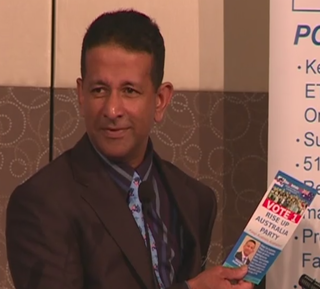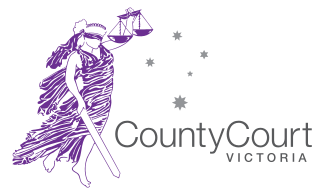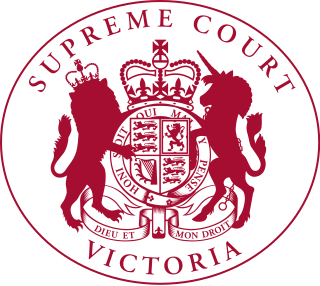Related Research Articles
Small-claims courts have limited jurisdiction to hear civil cases between private litigants. Courts authorized to try small claims may also have other judicial functions, and go by different names in different jurisdictions. For example, it may be known as a county or magistrate's court. These courts can be found in Australia, Brazil, Canada, England and Wales, Hong Kong, Ireland, Israel, New Zealand, Philippines, Scotland, Singapore, South Africa, Nigeria and the United States.
The court system of Canada forms the country's judiciary, formally known as "The King on the Bench", which interprets the law and is made up of many courts differing in levels of legal superiority and separated by jurisdiction. Some of the courts are federal in nature, while others are provincial or territorial.

Julian Knight is an Australian mass murderer. On 9 August 1987, he shot dead seven people and injured 19 during a shooting spree in Clifton Hill, Victoria, Australia, in what became known as the Hoddle Street massacre.

Daniel "Danny" Nalliah is a Sri Lankan Australian evangelical Christian pastor and young earth creationist. He was the leader of the now-dissolved Rise Up Australia political party and is the president of Catch the Fire Ministries. Nalliah defended against a lawsuit brought by the Islamic Council of Victoria under Victoria's Racial and Religious Tolerance Act. In this case, Judge Michael Higgins found in favour of the Islamic Council of Victoria, which took the action against Catch the Fire, but his decision was overturned by the Victorian Court of Appeal.

The Magistrates' Court of Victoria is the lowest court in the Australian state of Victoria.

The County Court of Victoria is the intermediate court in the Australian state of Victoria. It is equivalent to district courts in the other states.
Australian administrative law defines the extent of the powers and responsibilities held by administrative agencies of Australian governments. It is basically a common law system, with an increasing statutory overlay that has shifted its focus toward codified judicial review and to tribunals with extensive jurisdiction.
The State Administrative Tribunal (SAT) was established in Western Australia in 2005 as an independent body that makes and reviews a range of administrative decisions. Individuals, businesses, public officials and vocational boards can bring before the SAT many different types of applications related to civil, commercial and personal matters. These range from reviews of multimillion-dollar tax judgments and dog destruction orders to disciplinary proceedings, guardianship questions and town planning and compensation issues.

A supreme court is the highest court within the hierarchy of courts in most legal jurisdictions. Other descriptions for such courts include court of last resort, apex court, and highcourt of appeal. Broadly speaking, the decisions of a supreme court are not subject to further review by any other court. Supreme courts typically function primarily as appellate courts, hearing appeals from decisions of lower trial courts, or from intermediate-level appellate courts.

The Supreme Court of Victoria is the highest court in the Australian state of Victoria. Founded in 1852, it is a superior court of common law and equity, with unlimited and inherent jurisdiction within the state.

The Federal Circuit Court of Australia, formerly known as the Federal Magistrates Court of Australia or the Federal Magistrates Service, was an Australian court with jurisdiction over matters broadly relating to family law and child support, administrative law, admiralty law, bankruptcy, copyright, human rights, industrial law, migration, privacy and trade practices.

The Scottish Land Court is a Scottish court of law based in Edinburgh with subject-matter jurisdiction covering disputes between landlords and tenants relating to agricultural tenancies, and matters related to crofts and crofters. The Scottish Land Court is both a trial court and an appeal court; hearings at first-instance are often heard by a Divisional Court of one of the Agricultural Members advised by the Principal Clerk. Decisions of the Divisional Court can be appealed to the Full Court, which will consist of at least one legally qualified judicial member and the remaining Agricultural Member. Some cases are heard at first-instance by the Full Court, and these cases may be appealed to the Inner House of the Court of Session.
The Racial and Religious Tolerance Act 2001 is an Act of the Parliament of Victoria, Australia, that makes behaviour that incites or encourages hatred, serious contempt, revulsion or severe ridicule against another person or group of people, because of their race or religion, unlawful in Victoria. The Act was passed during the premiership of Steve Bracks and went into effect on 1 January 2002.
The Consumer, Trader and Tenancy Tribunal of New South Wales was a tribunal that specialises in resolving consumer disputes in New South Wales, a state of Australia. The tribunal has concurrent jurisdiction in respect of certain consumer claims with the normal civil courts of New South Wales. In other areas of consumer law, it has exclusive jurisdiction. It was created on 25 February 2002 and ceased to function on 31 December 2013, its function assumed by the New South Wales Civil and Administrative Tribunal (NCAT).

The Provincial Court of Alberta is the Provincial Court for the Canadian province of Alberta. The Court oversees matters relating to criminal law, family law, youth law, civil law and traffic law. The current Provincial Court is the first point of contact between the justice system and an individual in Alberta. More than 170,000 matters come before the Provincial Court of Alberta every year.
Stuart Morris is an Australian lawyer. He served as a Justice of the Supreme Court of Victoria and as President of the Victorian Civil and Administrative Tribunal (VCAT) from 2003 until 2007. Former Chairman of the Victorian Government's Local Government Commission, 1986 under the Cain Government. Stuart Morris worked as a barrister, and was one of Australia's leading lawyers in planning law. He was appointed a Queen's Counsel in 1991.
The Landlord and Tenant Board is an adjudicative tribunal operating in the province of Ontario that provides dispute resolution of landlord and tenant matters under the Residential Tenancies Act, 2006. It is one of the 13 adjudicative tribunals overseen by the Ministry of the Attorney General that make up Tribunals Ontario.
The judiciary of Luxembourg comprises a number of courts.

The New South Wales Civil and Administrative Tribunal (NCAT) is a civil law and administrative law tribunal in New South Wales established by statute on 1 January 2014.
References
- ↑ Victorian Civil and Administrative Tribunal
- ↑ Victorian Civil and Administrative Tribunal Act 1998 (Vic).
- ↑ King, Michael (2013). "Still not a court: Limitation to VCAT's expanded jurisdiction". Law Institute of Victoria.
VCAT is a creature of statute and only has the jurisdiction and powers that parliament conferred on it. It has no inherent jurisdiction or powers.
- ↑ Director of Housing v Sudi [2011] VSCA 266 , Court of Appeal (Vic,Australia).
- ↑ "Our structure | VCAT". www.vcat.vic.gov.au. Retrieved 30 August 2021.
- ↑ "Corporate Reporting". Victorian Civil and Administrative Tribunal.
- ↑ 55 King Street, Melbourne, Google maps
